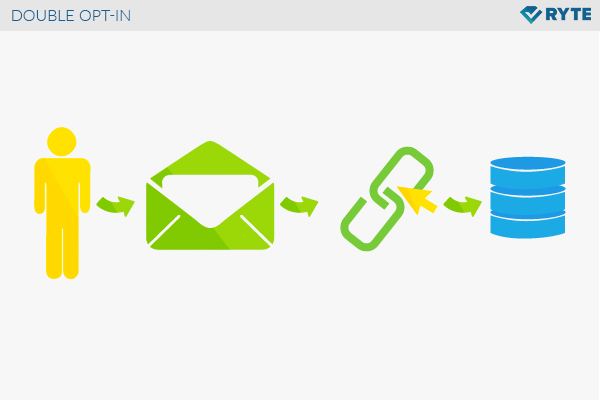Double Opt-In
Double opt-in is an online marketing procedure, in which the subscriber of a newsletter or submission form must reconfirm their consent in a second step, as opposed to a single opt-in. This method is one of today's most common procedures to obtain permission to send emails. However, it has not been conclusively clarified (as of October 2020) whether the double opt-in creates comprehensive legal security.
Background
Due to stricter advertising laws, online retailers and companies must pay closer attention to ensure that emails are not sent without the recipient’s consent (so-called permission marketing). In extreme cases of unwanted advertising, six-figure warning costs are possible. Consequently, a legally compliant solution is necessary in order to get customers’ or prospective customers’ permission to be contacted, especially in email marketing. For a long time, single opt-in was also used here and it was sufficient to enter one's email address in a list in order to receive newsletters or emails. However, this practice has proven to be unsuitable, as abuse by third parties is easily possible. The double opt-in procedure, on the other hand, has proved reliable many times for newsletter subscriptions, informational email, and push notifications from apps or even information via text. While the double-opt in procedure is not legally required, it's one of the few ways to safely prove that you've obtained permission to process data and send emails.
Opt-in vs. Opt-out
While with an opt-in, a user or customer needs to actively checks a box and agrees to have their data processed, an opt-out has the checkbox prefilled and requires to user to deselect it, should they not want their data to be processed e.g. for a newsletter subscription. According to the GDPR, this “soft opt-in” or “opt-out” approach does not qualify as an agreement for data processing and is therefore not a legal prequisite for a newsletter subscription.
Disadvantages
Since users have to confirm the receipt of emails or newsletters by clicking on a link, there is a possibility that the user decides against their subscription after their registration. Additionally, the confirmation mail might end up in a spam folder or be forgotten. To ensure that customers click on the confirmation mail, many online stores work with vouchers for newsletter subscriptions, for example, which are sent only after the successful confirmation. A further disadvantage is the greater administrative and technical effort that webmasters have to make in order to use the double opt-in procedure. At the same time, this procedure also has the disadvantage that to date (as of October 2020) it does not represent a clear, 100% legally secure solution and, in the event of an emergency, legal disputes could repeatedly arise.
Advantages
The double opt-in procedure essentially offers a legally secure possibility through which companies can confirm the receipt of emails by their customers or interested parties. It is important that certain rules are followed when setting up the confirmation mail.
German Double Opt-In Requirements
In 2012, the Munich Higher Regional Court had interpreted the confirmation mail as spam in the double opt-in procedure. In 2014, a Berlin court also classified the second mail as advertising, since the recipient had not expressly agreed to the email. However, in 2016 the Duesseldorf Higher Regional Court countered this, saying that companies had no other choice than to send a confirmation mail. [1] To ensure that the double opt-in is legally secure, does not violate the law against unfair competition, [2] and to avoid warnings, senders must follow a few rules:
- neither advertising nor offers may be included in the confirmation mail
- the email should only confirm the receipt of the newsletter
- the email may only consist of standard information on the double opt-in and data security procedure
- the first entry should be logged (IP address of the recipient, timestamp, etc.)
The last point is one of the most important aspects. In the event of a dispute, the sender of the advertising email must be able to prove that the recipient has actually agreed to receive the mail. A double opt-in can, in theory, prevent emails from being sent without the agreement of the receiver.
Uses for Online Marketing
Even if the double opt-in doesn’t currently offer absolute legal certainty, it’s a more secure solution than the single opt-in. In principle, marketers and webmasters have the proof to prove that a person has agreed to receive advertising or informational material. The doubled confirmation also screens out recipients who weren’t interested in receiving marketing material. In addition to the partially improved legal situation, this increases the chances that the recipient will also read and engage with the newsletters that he or she has requested.
Category
- ↑ Zwei verschiedene OLG-Auffassungen: Bestätigungsmail beim Double-Opt-In-Verfahren nun doch kein Spam? Kanzlei Hoesmann Last opened 24.11.2020
- ↑ Section 7 Unacceptable nuisance §2 Sentence 3 UWG gesetze-im-internet.de. Last opened 24.11.2020

